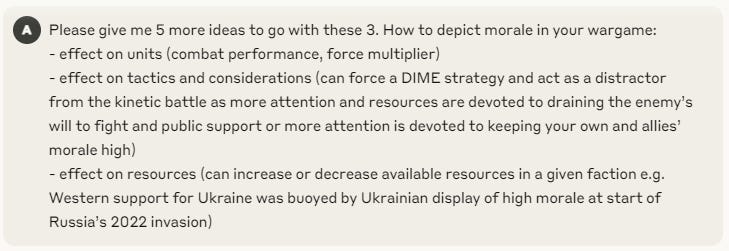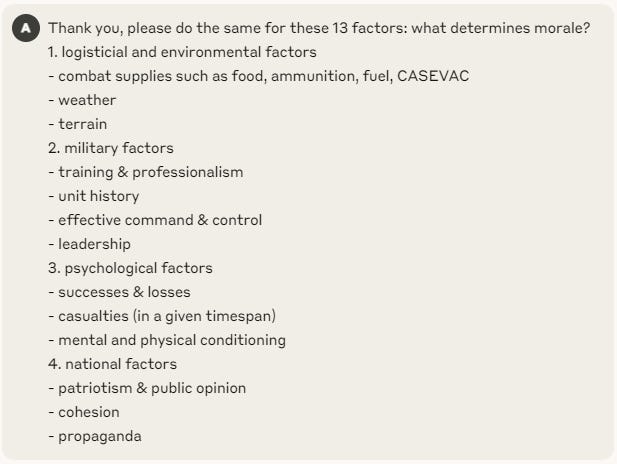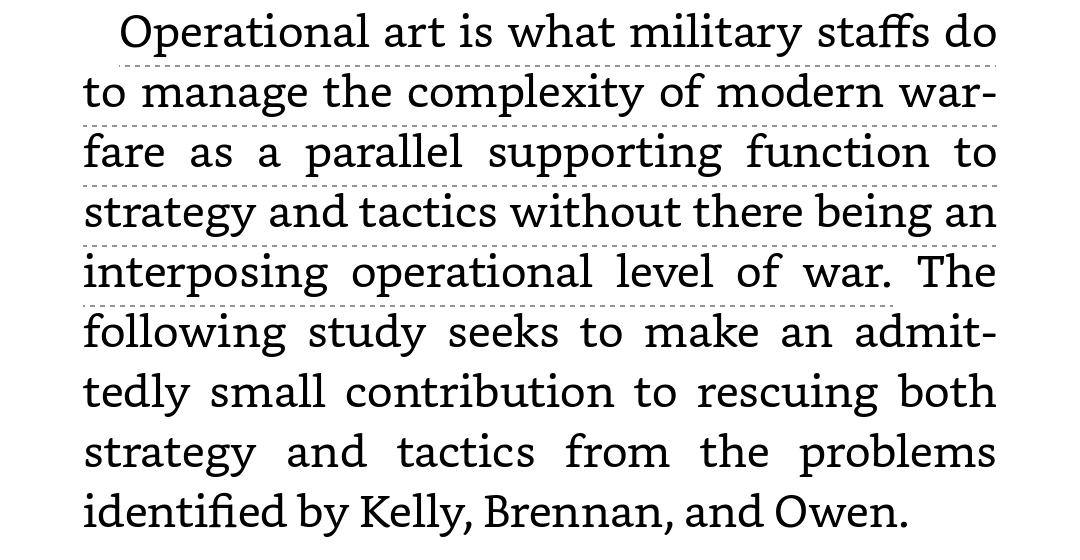Wargaming Weekly #027: Are we ready for AI-powered wargaming? (Part 2)
“Are machines moving units on maps?” vs. “Is it a wargame when you have the AI playing the game?”
I finally came around to watching the “Using AI in Wargames” presentation at the recent Connections Online 2025 conference featuring Aaron Frank, Eleanor Ross, Ezra Sidran, Paul Vebber and Chris Weuve.
Below, I explore their respective insights that stood out the most to me:
1. Eleanor Ross highlighted that AI is democratizing wargame design
I couldn’t agree more. In fact, I have a confession… remember those 24 game mechanic ideas that I shared last week on how to model morale in wargaming?
Well, guess who I brainstormed them with? Claude!
In a nutshell, my standard approach to using AI as a creative partner is to craft a clear prompt asking for the tool’s top 3 suggestions, and then use my human judgement to do one of three things:
· pick the best one
· combine two into one
· discard all three altogether
2. Aaron Frank explored how AI can be employed in three useful ways
On top of exploring both the potential applications and challenges of using AI in the various gaming steps (preparation, play, adjudication, analysis) he also shared how AI can be employed in three useful ways:
· discover challenging circumstances that make the most of human attention and effort
· increase the complexity of the games we play, placing players in increasingly stressful and challenging circumstances (move from playing finite games to infinite games)
· hand off lessons from games as hypotheses to be tested via other means
I’m intrigued by the idea of infinite games. I feel like there’s a really good, very twisted Black Mirror episode in there.
Anyway, weird doomer sci-fi shows aside, three more things that Aaron shared stood out for me:
· The “engine” versus “camera” problem (we think about models as cameras i.e. they take a snapshot of the world but in fact, when we connect them to our choices, they become engines)
· “The world in the data” versus “the world beyond the data” (AI is already great at finding unique insights in existing data but still horrible at postulating ideas outside that data)
· This quote by Yuna Wong, founder and President of the Women's Wargaming Network: “My biggest fear is that computers will do all the learning and humans will do none of it.”
3. Ezra Sidran is only interested in getting machines to move units on maps
I totally agree. As a solo wargamer who doesn’t have a fellow hobbyist nearby to play with, AI opponents are my best friends. But hobby wargaming aside, how can this actually be implemented in serious wargames since most professional wargaming seems to happen on physical table tops?
· Perhaps a human with a GoPro feeding visual content to the AI that then instructs them which pieces to move?
· Perhaps the AI could be hooked to one of Elon’s humanoid robots and we just cut the fleshy middleman out?
· Or is it easier for us to just meet AI on its digital home turf where it can easily move pieces, by replacing physical boards and pieces with digital screens and icons?
Ezra also highlighted that according to multiple surveys (including research by DARPA), commanders in the field don’t want to be second-guessed by AI, no matter how you brand it.
“I hear what you are saying and I believe you are right but I can’t make decisions based on that unless I can connect it to my own experience.”
Besides being absolutely hilarious, I think this is perfectly natural: we humans are extremely territorial monkeys, why wouldn’t we be irrationally insecure about a foreign intelligence intruding on the cognitive space that has always been under our sole control?
I can tell you that as a professional marketing writer, at first I didn’t want to use AI writing tools at all, then I started using them but was very ashamed to admit that I did use them and now, as you can see above, I have no problem admitting to it and even sharing my prompts!
More behavioral science effort should be put in catalyzing the necessary cultural change that will take commanders from completely shunning AI to using it while being ashamed of it and finally, to being proudly AI-enabled.
Like Eleanor highlighted, America’s adversaries are already using AI… and the industry as a whole is not slowing down either. Sam Altman is really determined to feed all our jobs to his baby and now he’s raising half a trillion dollars to do just that!
4. Paul Vebber also explored how AI can contribute to the various gaming steps
Here are some of the ideas he shared:
· potential for “project management assistant” AI tools
· generative AI text tools can help with some of the narrative crafting
· generative AI rendering tools can be used to produce graphics and visual elements
· “pre-generate” likely engagement outcome distributions and advise players
· AI agents as “generative surrogates” for NPCs especially for narrative-driven games
· AI agents to communicate “commander’s intent” to the white cell
· AI helping humans understand variability in the known unknowns and anticipate unknown unknowns (reference to Aaron’s “the world in the data” vs “the world beyond the data”)
All these are really potent ideas but the highlight of Paul’s presentation for me was the question he posed: “Is it a wargame when you have the AI playing the game?”
I know I just said AI opponents are my best friends but even as a hobbyist, I know I won’t be a truly certified wargamer until I play (and mercilessly beat) a human opponent.
5. Chris Weuve also explored the potential contribution of AI to the various gaming steps
He pointed out that LLMs can be used for:
· injects
· help with adjudication
· tactical decision aid (emulating a staff)
· helping with analysis
Emulating a staff is most interesting to me especially since I just finished reading B.A. Friedman’s latest book “On Operations” where he highlights that operational art is what general staffs do.
I think it would be interesting to have a wargame with six AI agents, one for each of the six disciplines of operational art that Friedman identified in the book, where your job as the player is to configure, deploy and collaborate with them as needed.
Chris also touched on using AI to take the output of one game and use it as the input of another game. Perhaps this could be one manifestation of Aaron’s “infinite games” idea.
Why AI in wargaming cannot escape from the objective
In my opinion, Ezra Sidran’s “Are machines moving units on maps?” and Paul Vebber’s “Is it a wargame when you have the AI playing the game?” capture the natural (and necessary) divide in the logic of educational wargaming and that of analytical wargaming. You can still gain real lessons even if you’re playing against an AI opponent but you can never call it analytical wargaming if you’re not playing against a human.
I have noticed that analytical wargaming is very sensitive. Paul defines analytic wargames as “designed to elicit information from players that informs analytic exploration of a decision space” and highlights that in analytic wargames, you’ve got to sometimes drive the players down a certain path to get at the decisions that you’re interested in.
Educational wargaming seems more robust and less strict. No wonder it has even started finding commercial success with Sebastian Bae’s Littoral Commander now inspiring James Buckley at Sapper Studios to attempt the same with creating Battlegroup Clash: Baltics, a commercial version of Vedette Consulting’s Battlegroup Wargaming System (BGWS) that they developed for the British Army.
But yes, I see why AI players have no place in analytical wargaming: I think in that realm, AI will best be applied to adjudication and analysis. Also, in this War on the Rocks piece from 2019 that I recently shared, Dr. Ed McGrady accused “analytical wargaming” of being an intentionally vague term “that can mean anything, and often does.” Hopefully, the issues he raised have since been addressed.
Oh, and what have the two startups mentioned in “Are we ready for AI-powered wargaming?” (Part 1) been up to lately?
While the only news that has come out of Onebrief since my last newsletter on AI in wargaming has been growing its leadership team, Exia Labs has been very busy:
1. They have released Blue, which is described as a “copilot for military operations.” (Will it suffer Ezra’s warning about commanders in the field not wanting to be second-guessed by AI?)
2. They have started working on a digital version of Mr President by GMT Games (I’m eagerly awaiting this, hoping to have sorted out my outdated computer issues by the time it drops on Steam in July)
3. They have been selected to participate in the first Palantir Startup Fellowship (This is really huge, given that Palantir is a pioneer and leader in the defense software startup game)
Lastly… what’s that over there in the Business Corner?
Speaking of Palantir, I recently watched this interview of Nabeel S. Qureshi (ex-Palantir) on Lenny’s Podcast, where they discussed how Palantir built the ultimate founder factory (many ex-Palantir employees go on to start their own successful startups).
Nabeel revealed that in hiring product managers (PMs), Palantir screened really hard for a few traits:
· very independent minded people (people who weren’t afraid to push back, who questioned the frame of everything and thought for themselves and had strong convictions)
· people with broader intellectual interests (co-founder Karp just released a new book ”The Technological Republic” and he’s quoting German philosopher, Jürgen Habermas)
· people who are intensely competitive
Why does that sound a lot like the typical hobbyist wargamer?!
More about what helped to set Palantir’s company culture apart:
· A founder had to interview you
· They didn’t have job titles to mitigate Goodhart’s law
· They were extremely careful about only making people PMs who had first proven themselves out as forward-deployed engineers (you basically could not become a PM any other way)
“Forward-deployed engineers” is such a beautiful phrase. I love when business people shamelessly borrow military terms. After all, business is “war by other means”, right?
Yours in hex,
Rwizi.
PS: I’m soft-launching my wargaming consultancy! If you have a wargaming project (be it defense or corporate wargaming) that you think could use the brain of a millennial B2B marketer/startup founder who reads way too many PDFs and watches way too many YouTube videos on wargaming, military theory and product management, then please feel free to reach out to me via X or LinkedIn. Like the Gen Z kids like to say nowadays… lemme cook!
…
SUPPORT MY NEWSLETTER!
If you enjoy this newsletter, you can support me in any one of the following three super-specific ways:
1. Leave a comment below! (Punching a good hole in any of the facts or arguments shared above.)
2. Hire me for a wargaming consulting gig! (I’m currently available for content writing and/or game co-designing roles for both defense and corporate wargaming projects as a part-time freelancer i.e. 10 – 20 hours per week. Please DM me via X or LinkedIn to book a call.)
3. Give me a warm intro to your friend at a16z! (Preferably someone who’s on either the a16z speedrun team or the a16z Games team. I’m looking for brutal feedback on a speedrun application my startup made last year: once again, please DM me via X or LinkedIn to sync.)
ABOUT THE AUTHOR:
Wargaming Weekly is curated, written and published by Rwizi Rweizooba Ainomugisha, a freelance writer, game designer and startup entrepreneur. Rwizi currently serves as Co-Founder, Co-CEO and Chief Strategy Officer (CSO) at Lupiiya Books - the social finance app that is gamifying the fundraising process for young African entrepreneurs. Wargaming Weekly is a curiosity chronicle of Rwizi’s exploration of the wargaming world… for the love of games in general, for the desire to contribute to the growth of wargaming in particular as a discipline, and lastly, for the hope of finding cutting-edge game design innovations to bring back with him to the startup world.










